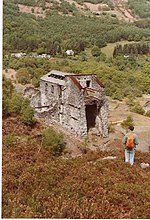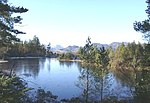Trefriw

Trefriw (Welsh pronunciation: [trɛˈvrɪu]) is a village and community in Conwy County Borough, Wales. It lies on the river Crafnant a few miles south of the site of the Roman fort of Canovium, sited at Caerhun. At the last three censuses, the population of the community has been recorded as 842 in 1999, 915 in 2001, and 783 in 2011 (from a total of 368 households).Trefriw lies on the edge of Snowdonia, on the B5106 road to the north-west of Llanrwst, and about 4½ miles north of Betws-y-Coed by road. It is located on the western slopes of the glaciated Conwy valley, below the ridge of Cefn Cyfarwydd, the village having been largely built in a semicircle at the point where the river Crafnant flows from its hanging valley to join the river Conwy. The river Crafnant still provides power for the woollen mill, and in the past provided power for a number of other industries based along its banks, such as a forge which provided quarry tools. The community includes the hamlet of Llanrhychwyn. Most of the village lies within the Snowdonia National Park, the boundary running down the main street of the village. Apart from its reputation as a good starting point for walks (the village has Walkers are Welcome status and stages an annual walking festival), Trefriw is today mostly known for its woollen mill, and for the nearby chalybeate spa, first known to have been used by the Romans and further developed in about 1700. Its waters were one of very few throughout Europe to have been classified as a medicine due to their high iron content.
Excerpt from the Wikipedia article Trefriw (License: CC BY-SA 3.0, Authors, Images).Trefriw
Tan y Fedw,
Geographical coordinates (GPS) Address Nearby Places Show on map
Geographical coordinates (GPS)
| Latitude | Longitude |
|---|---|
| N 53.152 ° | E -3.825 ° |
Address
Tan y Fedw
LL27 0JG , Trefriw
Wales, United Kingdom
Open on Google Maps










